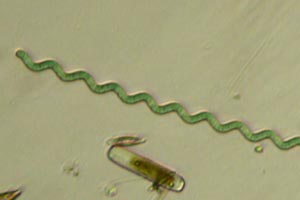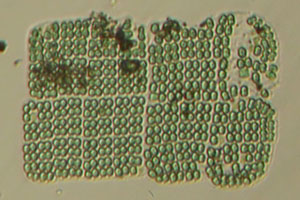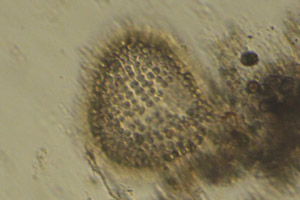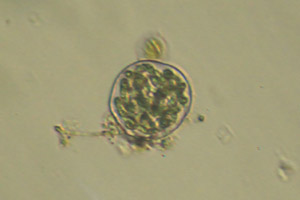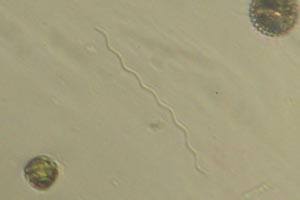Bacteria are prokaryotes, lacking more complex internal structures such as cell nuclei. Most are small, usually only a few micrometres, and round or rod-shaped. They are ubiquitous and extremely diverse in the chemical reactions they perform, but very few kinds can be recognized by appearance.
Cyanobacteria are common photosynthetic bacteria, unique in using water as their hydrogen source and so producing oxygen as a by-product. They may be bluish-green or other colours, with the pigments appearing uniformly spread in each cell but actually associated with internal membranes.
A wide variety of cyanobacteria form simple filaments. These are often capable of gliding, a type of slow movement from directed secretions, during which they turn about their axis. Some also form sheaths or envelopes, which may have yellowish or brown pigments or enclose several series of cells.
Oscillatoriales
Latin oscillare, to swing
Angl. OS-i-la-TOR-ee-AY-leez
Oscillatoriales are one of a few orders of filaments with typically disc-shaped cells, usually wider than long. They are found in a wide variety mats and films.
These are hard to distinguish but some are relatively rigid, and of these corkscrew-shaped filaments appear distinctive here.
A few orders like Chroococcales and Nostocales also include some more distinctive forms. In Chroococcales cells frequently divide in multiple planes, which then leads to various sorts of colonies or sometimes special dispersal cells.
Merismopedia
Greek merismos, division, pedion, plain
Angl. me-RIZ-mo-PEE-deea
Merismopedia form sheet-like colonies embedded in mucilage. The cells are arranged in a regular grid, resulting from divisions in two perpendicular planes.
Woronichinia
After Nikolai Voronikhin, 1882-1956
Angl. WOR-o-ni-KIN-eea
Woronichinia form mucilaginous colonies with cells in an outer layer. Each has a stalk, faint but about as wide as the cell itself and sometimes extending past it.
These are among various cyanobacteria that can produce gas vesicles, which aid in flotation and give the cells a darker brownish appearance.
Nostocales
Perhaps Old English nosþyrl, nostril
Angl. NOS-to-KAY-leez
Nostocales typically have cells specialized for fixing nitrogen, becoming enlarged pale heterocysts, and some also have resting spores called akinetes.
Different types here take the form of simple chains of cells, tapering threads, or filaments with true branches. Some are further embedded in mucilaginous colonies.
Pseudomonadota are a broad group united by genetic characteristics. Some conduct photosynthesis, called purple bacteria, but most obtain energy from organic nutrients or by oxidizing inorganic material. They have thin cell walls and many move using flagella, though others are gliding or non-motile.
A few sorts are relatively large for bacteria. These notably include different spirilla, where having longer cells helps with propulsion, and some kinds that store up sulfur granules.
Spirilla are helix-shaped and inflexible, some in chains over 100 µm long. Most occur in stagnant and putrid water, rotating as they move by means of flagella at the ends.
Smaller spirilla also occur in some other phyla but rarely more than 1-1½ µm wide, along with other helical bacteria that instead move by flexing or gliding.
Sulfur acts as a reserve form of hydrogen sulfide, a degradation product formed in habitats with low oxygen. Chromatiales or purple sulfur bacteria take advantage as their hydrogen source for photosynthesis. They vary from purple to brownish and some form simple colonies similar to cyanobacteria.
Lamprocystis
Greek lampros, shining, kystis, bladder
Angl. LAM-pro-SIS-tis
Lamprocystis are purple to pink with round cells. These are packed close in small hollow spheres or larger branching aggregates, generally without prominent envelopes.
